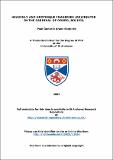Files in this item
Heavenly and grotesque imageries (re)created in the carnival of Oruro, Bolivia
Item metadata
| dc.contributor.advisor | Overing, Joanna | |
| dc.contributor.author | Sanjinés, Paul Gonzalo Araoz | |
| dc.coverage.spatial | 318 p. | en_US |
| dc.date.accessioned | 2017-06-26T12:30:28Z | |
| dc.date.available | 2017-06-26T12:30:28Z | |
| dc.date.issued | 2003 | |
| dc.identifier | uk.bl.ethos.516265 | |
| dc.identifier.uri | https://hdl.handle.net/10023/11084 | |
| dc.description.abstract | The dissertation focuses on the creation of imageries in the Carnival of Oruro, in Central-Western Bolivia, where images from different sources are formed and transformed through the development of the festival over time. The production of mythological narratives, religious figures, choreographic performances, costumes, and masks gives place to a complex of icons representing natural and supernatural beings, all of which are intertwined in the enactment of carnival in Oruro. Following the imposition of a strict dichotomy between good and evil, "heavenly" and "infernal" imageries are constructed to depict a prescribed and proscribed behaviour, respectively. However, the morality underpinning such constructs is often contradicted by the actual behaviour of the individuals involved. The hyperactivity of the lower bodily stratum epitomises an effective degradation of the elevated during the local celebration of the festival, rendering Bakhtin's approach appropriate for a study of the Oruro Carnival. Parallel to an analysis of the Carnival Parade, the dissertation provides a reflection on the discourses and practices inherent to the construction of a Bolivian national and cultural identity through the development of the festival. The symbolic oppositions observed in the Oruro Carnival Parade are linked to the transfigured images, which are analysed in relation to changes in the socio-cultural composition of the participants. Focusing upon the actual behaviour of the social actors involved, as much as upon representational activities, I intend to provide an insight into the relationship between the official imagery and the chaotic enactment of popular culture during carnival. | en_US |
| dc.language.iso | en | en_US |
| dc.publisher | University of St Andrews | |
| dc.subject.lcc | F3341.O7S2 | |
| dc.subject.lcsh | Oruro (Bolivia : Department) | en |
| dc.title | Heavenly and grotesque imageries (re)created in the carnival of Oruro, Bolivia | en_US |
| dc.type | Thesis | en_US |
| dc.contributor.sponsor | Overseas Research Students Awards Scheme (ORSAS) | en_US |
| dc.type.qualificationlevel | Doctoral | en_US |
| dc.type.qualificationname | PhD Doctor of Philosophy | en_US |
| dc.publisher.institution | The University of St Andrews | en_US |
This item appears in the following Collection(s)
Items in the St Andrews Research Repository are protected by copyright, with all rights reserved, unless otherwise indicated.

